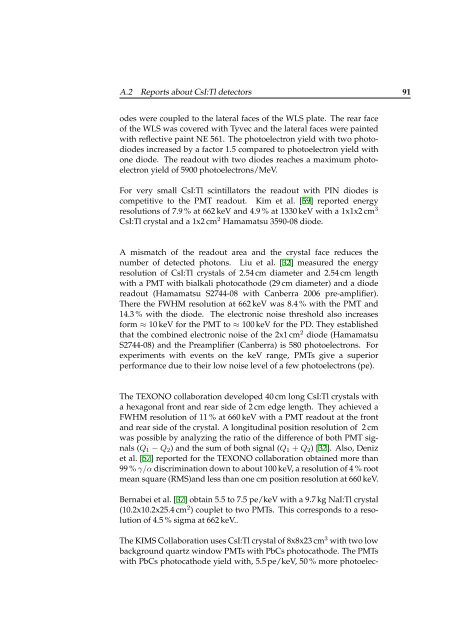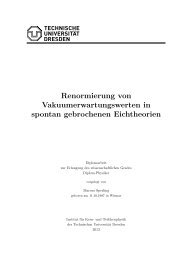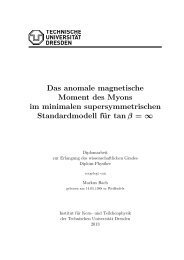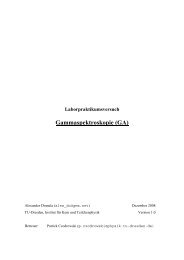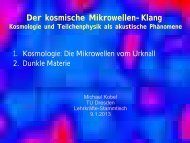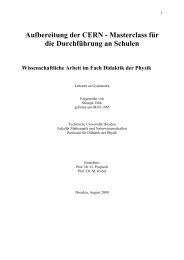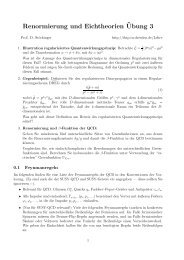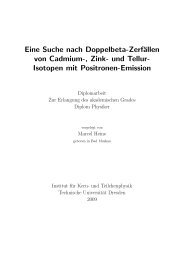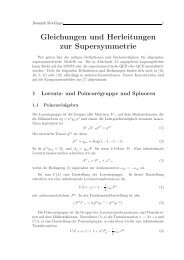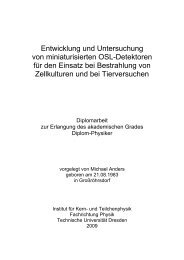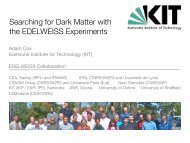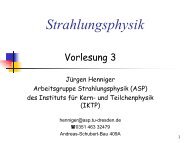a design study for a cobra upgrade to - Institut für Kern- und ...
a design study for a cobra upgrade to - Institut für Kern- und ...
a design study for a cobra upgrade to - Institut für Kern- und ...
Create successful ePaper yourself
Turn your PDF publications into a flip-book with our unique Google optimized e-Paper software.
A.2 Reports about CsI:Tl detec<strong>to</strong>rs 91<br />
odes were coupled <strong>to</strong> the lateral faces of the WLS plate. The rear face<br />
of the WLS was covered with Tyvec and the lateral faces were painted<br />
with reflective paint NE 561. The pho<strong>to</strong>electron yield with two pho<strong>to</strong>diodes<br />
increased by a fac<strong>to</strong>r 1.5 compared <strong>to</strong> pho<strong>to</strong>electron yield with<br />
one diode. The readout with two diodes reaches a maximum pho<strong>to</strong>electron<br />
yield of 5900 pho<strong>to</strong>electrons/MeV.<br />
For very small CsI:Tl scintilla<strong>to</strong>rs the readout with PIN diodes is<br />
competitive <strong>to</strong> the PMT readout. Kim et al. [59] reported energy<br />
resolutions of 7.9 % at 662 keV and 4.9 % at 1330 keV with a 1x1x2 cm 3<br />
CsI:Tl crystal and a 1x2 cm 2 Hamamatsu 3590-08 diode.<br />
A mismatch of the readout area and the crystal face reduces the<br />
number of detected pho<strong>to</strong>ns. Liu et al. [32] measured the energy<br />
resolution of CsI:Tl crystals of 2.54 cm diameter and 2.54 cm length<br />
with a PMT with bialkali pho<strong>to</strong>cathode (29 cm diameter) and a diode<br />
readout (Hamamatsu S2744-08 with Canberra 2006 pre-amplifier).<br />
There the FWHM resolution at 662 keV was 8.4 % with the PMT and<br />
14.3 % with the diode. The electronic noise threshold also increases<br />
<strong>for</strong>m ≈ 10 keV <strong>for</strong> the PMT <strong>to</strong> ≈ 100 keV <strong>for</strong> the PD. They established<br />
that the combined electronic noise of the 2x1 cm 2 diode (Hamamatsu<br />
S2744-08) and the Preamplifier (Canberra) is 580 pho<strong>to</strong>electrons. For<br />
experiments with events on the keV range, PMTs give a superior<br />
per<strong>for</strong>mance due <strong>to</strong> their low noise level of a few pho<strong>to</strong>electrons (pe).<br />
The TEXONO collaboration developed 40 cm long CsI:Tl crystals with<br />
a hexagonal front and rear side of 2 cm edge length. They achieved a<br />
FWHM resolution of 11 % at 660 keV with a PMT readout at the front<br />
and rear side of the crystal. A longitudinal position resolution of 2 cm<br />
was possible by analyzing the ratio of the difference of both PMT signals<br />
(Q1 − Q2) and the sum of both signal (Q1 + Q2) [32]. Also, Deniz<br />
et al. [57] reported <strong>for</strong> the TEXONO collaboration obtained more than<br />
99 % γ/α discrimination down <strong>to</strong> about 100 keV, a resolution of 4 % root<br />
mean square (RMS)and less than one cm position resolution at 660 keV.<br />
Bernabei et al. [37] obtain 5.5 <strong>to</strong> 7.5 pe/keV with a 9.7 kg NaI:Tl crystal<br />
(10.2x10.2x25.4 cm 2 ) couplet <strong>to</strong> two PMTs. This corresponds <strong>to</strong> a resolution<br />
of 4.5 % sigma at 662 keV..<br />
The KIMS Collaboration uses CsI:Tl crystal of 8x8x23 cm 3 with two low<br />
backgro<strong>und</strong> quartz window PMTs with PbCs pho<strong>to</strong>cathode. The PMTs<br />
with PbCs pho<strong>to</strong>cathode yield with, 5.5 pe/keV, 50 % more pho<strong>to</strong>elec-


